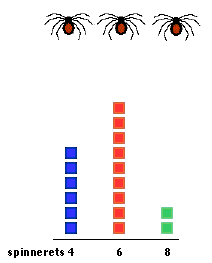Spiders - Lesson 7: Now We Know Spiders!
ACTIVITY: Spider Probability
On this page
- Encountering the Idea
- Exploring the Idea
- Getting the Idea
- Organizing the Idea
- Closure and Assessment
- List of Activities for this Lesson
Objectives
Given information about the number of spinnerets a group of spiders has, the
student makes a guess about the number of spinnerets a given spider from the
group has.
Materials
Multiple cards of pictures of spider spinnerets, as follows: nine with six
spinnerets; six with four spinnerets; and two with eight spinnerets.
Procedures
- The students count the number of spinnerets each spider has.
- The students place the pictures into three groups - those spiders that have
four, six or eight spinnerets.
- The students place each of the pictures on a pictograph, as below.
- They count the pictures in each group.
- Students identify the spinneret-group that has the most spiders in it. (The
six group, since it has nine spiders in it.)
- Students identify the spinneret-group that has the fewest spiders in it.
(The eight group, since it has two spiders in it.)
- Students identify the spinneret-group that has more than the smallest group
but less than the largest group of spiders in it. (The four group, since it has
six spiders in it.)
- The students take turns identifying the smallest and the largest groups
using the appropriate terminology; they say that six is greater than two, but six
is less than nine, and other similar comparisons.

After the students have had an opportunity to classify the pictures according to
the number of spinnerets the spiders have, discuss the following ideas with them
in a whole group activity.
Discussion
Tell the students that all spiders have either four, six or eight spinnerets.
Today, a new spider has come to join the group of spiders that students have
placed in the pictograph. Show the students an additional card, but do not let
them count the number of spinnerets.
- From the information the students have, which type of spider is the new
spider most likely to be - the four, the six, or the eight-spinneret type?
- Ask the students to make a guess. The students give their reasons for the
guess. (The six-spinneret type is the most likely type to appear; from the
sample, there are more pictures of the six-spinneret type than of the others.)
- Ask students, who would guess that the new spider has four spinnerets? (The
new spider could be of the four-spinneret type, but that is not as likely to
occur as the six-spinneret type. Maybe, the new spider would have four
spinnerets.)
- Ask students, who would guess that the new spider has eight spinnerets?
(The new spider could be of the eight-spinneret type, but that is not as likely
to occur as the six or the four-spinneret type. Maybe, the new spider would have
eight spinnerets, but the probability is that the new spider would not have eight
spinnerets.)
- Would any of the students guess that the new spider has only one spinneret?
Why? (All spiders have at least four spinnerets. It is not probable that the new
spider has only one spinneret.)
- Does the new spider have at least four spinnerets? Would you guess that
this spider has at least four spinnerets? (Yes, every spider will have four
spinnerets; some spiders may have two more, or six; others may have four more, or
eight, but every spider will have at least four.
|

